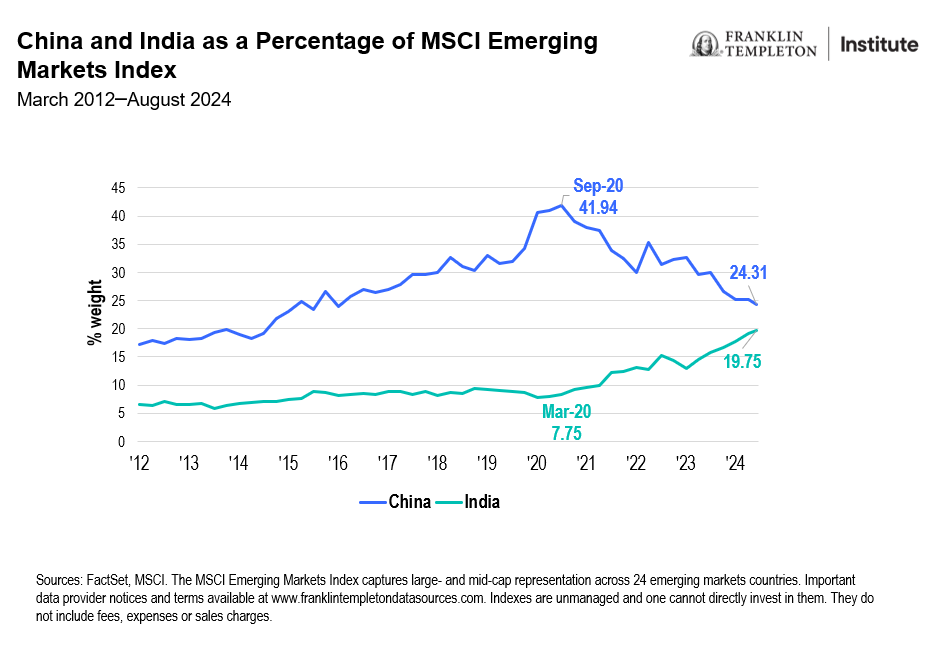Originally published in Stephen Dover’s LinkedIn Newsletter, Global Market Perspectives. Follow Stephen Dover on LinkedIn where he posts his thoughts and comments as well as his Global Market Perspectives newsletter.
Key takeaways:
- India’s equity markets are significantly increasing as a proportion of the emerging market equity universe due to the latest MSCI rebalancing. This is a strong indicator of India’s increased importance particularly relative to China.
- The MSCI rebalancing will likely be a catalyst for increased portfolio flows into India, further enhancing the market’s expansion potential. India has several growth drivers including a growing consumer base, a digital revolution, a manufacturing surge and infrastructure development.
- We see investment opportunities in financial services, technology and digital services, consumer discretionary and infrastructure and industrials.
MSCI rebalancing: A boost for India’s markets
The recent MSCI Emerging Markets Index rebalancing is a substantial development for India’s equity markets, in our view. Global funds tracking these indexes will need to increase their allocation to Indian equities, which could lead to a surge in liquidity and positive price impacts. Since 2020, India’s weight in the MSCI Emerging Markets Index has doubled to nearly 20%, while China’s allocation has decreased from 42% to 24% (see Exhibit 1). This shift underscores India’s growing influence in the global investment landscape and could drive an estimated US$3 billion in capital inflows,1 likely benefiting underrepresented sectors.
Exhibit 1: Growing Influence of Indian Equities
India’s structural growth drivers
India’s long-term market potential is underpinned by several key trends we see:
- Rising incomes and consumption: A rapidly expanding middle class (expected to double to over 60% of population by 20472) is fueling consumption growth, especially in premium goods and services. This demographic shift should continue to be a major driver for consumer goods, retail and financial services.
- Digital revolution: India’s digital transformation, bolstered by affordable data and widespread digital payments, opens new opportunities in e-commerce, fintech, and digital services. We believe these sectors look poised for sustained growth as digital penetration increases.
- Manufacturing surge: Structural reforms and geopolitical shifts are positioning India as a rising manufacturing hub, particularly in both the technology and industrial sectors.
- Infrastructure development: Government-led projects in infrastructure, such as smart cities and improved connectivity, are expected to drive growth in construction, materials and related industries.
Indian risks and impact
The Indian banking sector’s loans have grown at a faster pace as compared to deposits. Consequently, bank lending as a percent of gross domestic product (GDP) is at a level higher than pre-pandemic. With India’s central bank raising concerns, this could bring a crackdown on household credit, impacting consumption spending.
Additionally, the slowdown in government spending after the June elections likely dragged GDP growth for the April to June 2024 quarter.3 The government’s aim for fiscal consolidation could further curtail government spending. The government is targeting a fiscal deficit of 4.9% of GDP for the current fiscal year ending March 2025 and 4.5% of GDP for the fiscal year 2025-2026.4 The fiscal deficit for the year ending March 2024 was 5.6% of GDP.5 While the fiscal consolidation is expected to be offset by the government’s asset sales, any net reduction in government spending could impact GDP growth.
India’s long-term growth story
The post-election environment in India has set the stage for continued economic reforms and stability. In our view, the country’s political will and policy initiatives are creating a favorable environment for business and investment. The structural reforms introduced over the past decade have improved governance, streamlined regulations, and made India a more attractive destination for global capital.
India’s equity market performance has mirrored its GDP growth, reflecting the country’s increasing share of the global economy. As India continues its journey toward becoming the world’s third-largest economy by 2030, as per S&P Global Ratings,6 we believe the equity markets are likely to see sustained interest from both domestic and international investors.
Strategic investment opportunities
Key sectors we see benefiting from India’s growth trajectory include:
- Financial services: Rising incomes and digital innovation are driving demand for financial products.
- Technology and digital services: India’s leadership in IT and digital sectors positions them for continued growth.
- Consumer discretionary: The expanding middle class is shifting toward higher-end consumption which benefits consumer goods and retail sectors.
- Infrastructure and industrials: Government projects and urbanization have fueled long-term growth in construction and materials.
Conclusion
India’s equity markets are experiencing a sustained expansion, supported by economic reforms, strategic initiatives, and growing global investor interest. We believe the MSCI rebalancing is an important catalyst, likely to bring significant and lasting capital inflows. For investors, a diversified approach that capitalizes on India’s structural growth drivers, while being mindful of global risks, offers a compelling long-term opportunity.
WHAT ARE THE RISKS?
All investments involve risks, including possible loss of principal.
Equity securities are subject to price fluctuation and possible loss of principal. International investments are subject to special risks, including currency fluctuations and social, economic and political uncertainties, which could increase volatility. These risks are magnified in emerging markets. Investments in companies in a specific country or region may experience greater volatility than those that are more broadly diversified geographically.
IMPORTANT LEGAL INFORMATION
This material is intended to be of general interest only and should not be construed as individual investment advice or a recommendation or solicitation to buy, sell or hold any security or to adopt any investment strategy. It does not constitute legal or tax advice. This material may not be reproduced, distributed or published without prior written permission from Franklin Templeton.
The views expressed are those of the investment manager and the comments, opinions and analyses are rendered as at publication date and may change without notice. The underlying assumptions and these views are subject to change based on market and other conditions and may differ from other portfolio managers or of the firm as a whole. The information provided in this material is not intended as a complete analysis of every material fact regarding any country, region or market. There is no assurance that any prediction, projection or forecast on the economy, stock market, bond market or the economic trends of the markets will be realized. The value of investments and the income from them can go down as well as up and you may not get back the full amount that you invested. Past performance is not necessarily indicative nor a guarantee of future performance. All investments involve risks, including possible loss of principal.
Any research and analysis contained in this material has been procured by Franklin Templeton for its own purposes and may be acted upon in that connection and, as such, is provided to you incidentally. Data from third party sources may have been used in the preparation of this material and Franklin Templeton (“FT”) has not independently verified, validated or audited such data. Although information has been obtained from sources that Franklin Templeton believes to be reliable, no guarantee can be given as to its accuracy and such information may be incomplete or condensed and may be subject to change at any time without notice. The mention of any individual securities should neither constitute nor be construed as a recommendation to purchase, hold or sell any securities, and the information provided regarding such individual securities (if any) is not a sufficient basis upon which to make an investment decision. FT accepts no liability whatsoever for any loss arising from use of this information and reliance upon the comments, opinions and analyses in the material is at the sole discretion of the user.
Products, services and information may not be available in all jurisdictions and are offered outside the U.S. by other FT affiliates and/or their distributors as local laws and regulation permits. Please consult your own financial professional or Franklin Templeton institutional contact for further information on availability of products and services in your jurisdiction.
Brazil: Issued by Franklin Templeton Investimentos (Brasil) Ltda., authorized to render investment management services by CVM per Declaratory Act n. 6.534, issued on October 1, 2001. Canada: Issued by Franklin Templeton Investments Corp., 200 King Street West, Suite 1500 Toronto, ON, M5H3T4, Fax: (416) 364-1163, (800) 387-0830, www.franklintempleton.ca. Offshore Americas: In the U.S., this publication is made available by Franklin Templeton, One Franklin Parkway, San Mateo, California 94403-1906. Tel: (800) 239-3894 (USA Toll-Free), (877) 389-0076 (Canada Toll-Free), and Fax: (727) 299-8736. U.S. by Franklin Templeton, One Franklin Parkway, San Mateo, California 94403-1906, (800) DIAL BEN/342-5236, franklintempleton.com. Investments are not FDIC insured; may lose value; and are not bank guaranteed.
Issued in Europe by: Franklin Templeton International Services S.à r.l. – Supervised by the Commission de Surveillance du Secteur Financier – 8A, rue Albert Borschette, L-1246 Luxembourg. Tel: +352-46 66 67-1 Fax: +352-46 66 76. Poland: Issued by Templeton Asset Management (Poland) TFI S.A.; Rondo ONZ 1; 00-124 Warsaw. South Africa: Issued by Franklin Templeton Investments SA (PTY) Ltd, which is an authorized Financial Services Provider. Tel: +27 (21) 831 7400 Fax: +27 (21) 831 7422. Switzerland: Issued by Franklin Templeton Switzerland Ltd, Stockerstrasse 38, CH-8002 Zurich. United Arab Emirates: Issued by Franklin Templeton Investments (ME) Limited, authorized and regulated by the Dubai Financial Services Authority. Dubai office: Franklin Templeton, The Gate, East Wing, Level 2, Dubai International Financial Centre, P.O. Box 506613, Dubai, U.A.E. Tel: +9714-4284100 Fax: +9714-4284140. UK: Issued by Franklin Templeton Investment Management Limited (FTIML), registered office: Cannon Place, 78 Cannon Street, London EC4N 6HL. Tel: +44 (0)20 7073 8500. Authorized and regulated in the United Kingdom by the Financial Conduct Authority.
Australia: Issued by Franklin Templeton Australia Limited (ABN 76 004 835 849) (Australian Financial Services License Holder No. 240827), Level 47, 120 Collins Street, Melbourne, Victoria 3000. Hong Kong: Issued by Franklin Templeton Investments (Asia) Limited, 62/F, Two IFC, 8 Finance Street, Central, Hong Kong. Japan: Issued by Franklin Templeton Investments Japan Limited. Korea: Issued by Franklin Templeton Investment Trust Management Co., Ltd., 3rd fl., CCMM Building, 12 Youido-Dong, Youngdungpo-Gu, Seoul, Korea 150-968. Malaysia: Issued by Franklin Templeton Asset Management (Malaysia) Sdn. Bhd. & Franklin Templeton GSC Asset Management Sdn. Bhd. This document has not been reviewed by Securities Commission Malaysia. Singapore: Issued by Templeton Asset Management Ltd. Registration No. (UEN) 199205211E, 7 Temasek Boulevard, #38-03 Suntec Tower One, 038987, Singapore.
Please visit www.franklinresources.com to be directed to your local Franklin Templeton website.
Copyright © 2024 Franklin Templeton. All rights reserved.
_______________________________
1. Source: “India’s weight on key MSCI equity index rises to record high; $3 bln inflows likely.” Reuters. August 13, 2024.
2. Source: “Indian middle class will nearly double to 61% by 2046-47: PRICE Report.” India Brand Equity Foundation. July 2023.
3. Source: “India’s growth likely slowed to 6.9% last quarter as government spending lagged.” Reuters poll. August 25, 2024.
4. Source: “India lowers fiscal deficit target to 4.9% of GDP for FY25.” Reuters. July 23, 2024.
5. Source: “India’s FY24 fiscal deficit improves to 5.63% of GDP, narrower than government’s target of 5.8%.” Mint. May 31, 2024.
6. Source: “India to be world’s third-largest economy by 2030 -S&P Global Ratings.” Reuters. December 5, 2023.


